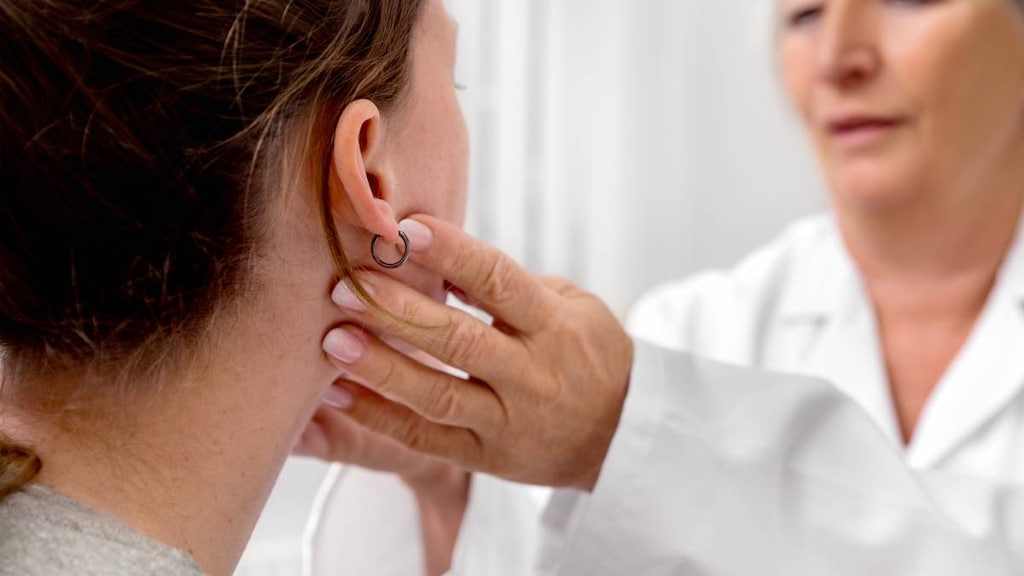Hodgkin's Versus Non-Hodgkin's Lymphoma — The Differences Explained

It's easy to confuse Hodgkin's and non-Hodgkin's lymphoma (NHL), cancers that attack the lymphatic system. Both can affect adults and children, and symptoms for both include swollen lymph nodes, fever, night sweats, fatigue and weight loss. However, there are key differences between the conditions.
NHL is one of the most common cancers in the United States. The American Cancer Society estimates that more than 74,000 adults and children will be diagnosed with NHL in 2019, about 4 percent of all cancer diagnoses.
NHL spreads randomly through the lymphatic system, a part of the immune system that includes the spleen, thymus, lymph nodes and lymph channels, tonsils and adenoids. More than 90 types of NHL have been identified, the most common being diffuse large B-cell lymphoma (DLBCL). It accounts for 22 percent of NHL cases in the United States.
In contrast, an estimated 8,100 people will be diagnosed with Hodgkin's lymphoma in 2019, according to the American Society for Clinical Oncology. Almost all Hodgkin's lymphomas contain what are known as Reed-Sternberg cells, a specific type of large cancer cell that is not present in NHL.
Hodgkin's lymphoma spreads in an orderly manner through groups of lymph nodes, which are small structures that contain white blood cells to fight infection. There are hundreds of lymph nodes in the body, but Hodgkin's lymphoma most often attacks the nodes in the neck, groin and underarms.
The most common form of Hodgkin lymphoma is nodular sclerosing Hodgkin's lymphoma, which accounts for 60 to 80 percent of diagnoses, according the University of Texas MD Anderson Cancer Center. The affected lymph nodes have mixed areas of normal cells, Reed-Sternberg cells and prominent scar tissue. Nodular sclerosing Hodgkin lymphoma can occur at any age but appears most often in adolescents and young adults.
The staging system
Treatment of cancer is based on the type of cancer — in this case, whether it's Hodgkin's or NHL — and stage of the cancer. The most common staging system for this type of cancer is the Lugano system, named for Lugano, Switzerland, where physicians from around the world adopted a new staging system during the 11th International Conference on Malignant Lymphoma in June 2011.
As defined by the American Cancer Society, lymphoma staging is based on the extent to which the cancer has spread throughout the body. Physicians determine stage based on a variety of tests, which may include a physical exam, PET or CT scan and a lymph node biopsy.
Lymphomas are staged from 1 to 4 (often denoted by Roman numerals, I to IV), with stage 4 being the most serious. A lymphoma that affects an organ outside the lymph system, known as an extranodal organ, is designated with an “E.”
In addition to stage, lymphomas can also be “bulky” — the term that's used to describe large tumors in the chest, which often require more intensive treatment.
- Stage 1: The disease affects one lymph node area or lymphoid organ, such as the tonsils, or it affects a single organ outside of the lymph system (1E).
- Stage 2: The disease affects at least two groups of lymph nodes either above or below the diaphragm, or it affects a group of lymph node and one area of a nearby organ (2E). The tumor may also be found in other groups of lymph nodes on the same side of the diaphragm.
- Stage 3: The disease affects lymph node areas both above and below the diaphragm, or it affects lymph nodes both above the diaphragm and in the spleen.
- Stage 4: The disease affects at least one organ outside the lymph system, such as the bone marrow, liver or lung.
Treatment options
Lymphomas are usually treated with some combination of surgery, stem cell transplantation, chemotherapy, radiation therapy and immunotherapy, such as monoclonal antibodies, immune checkpoint inhibitors and CAR T cells. There's also targeted therapy with drugs that block certain functions within the lymphoma cell. The choice of treatment depends on such factors as patient preference, disease stage and type and potential side effects.
For people with indolent (slow-growing) disease, what's called "watchful waiting" may be an option if the person is otherwise healthy and not experiencing symptoms. For this method, also known as watch-and-wait or active surveillance, the doctor closely monitors the patient through physical examinations, CT scans or other imaging tests and laboratory tests on a regular basis. Treatment begins only if the patient develops symptoms or tests indicating that the cancer is getting worse.
Comparing symptoms
For someone with NHL, symptoms may include:
- Drenching night sweats
- Fever and chills that come and go
- Itching
- Swollen lymph nodes in the neck, underarms, groin or other areas
- Weight loss
- Coughing or shortness of breath if the cancer affects the thymus gland or lymph nodes in the chest
- Abdominal pain or swelling, leading to loss of appetite, constipation, nausea and vomiting
- Headache, concentration problems or personality changes. Seizures are possible if the cancer affects the brain.
- Superior vena cava syndrome (SVCS), a life-threatening symptom of NHL that requires immediate medical attention. In SVCS, a tumor in the chest behind the breastbone blocks the flow of blood in the vein that carries blood from the head and arms to the heart, causing the head and arms to swell.
For someone with Hodgkin's lymphoma, symptoms may include:
- Painless swelling of the lymph nodes in the neck, armpits or groin
- Fever and chills
- Night sweats
- Weight loss
- Loss of appetite
- Itching
Comparing survival trends
- NHL: According to the National Cancer Institute’s SEER data, the five-year survival rate is 72 percent. The number of cases fell by about 1 percent a year from 2006 to 2016, and death rates declined by 2.2 percent a year from 2007 to 2016. As a result, there were nearly 695,000 people living with NHL in 2016.
- Hodgkin's lymphoma: The vast majority of people who develop Hodgkin lymphoma survive at least five years after diagnosis — 86.6 percent, according to SEER data. On average, incidence rates have fallen by an average of 1.8 percent each year from 2006 to 2016. Death rates have fallen by an average of 4 percent each year from 2007 to 2016. As of 2016, nearly 211,000 people in the United States were living with Hodgkin's lymphoma.
Comparing risk factors
For NHL, risk factors include:
- Age. Although NHL can affect children, teens and adults, risk increases with age. The disease is found most often in people in their 60s and 70s.
- Gender. Men are slightly more likely to develop NHL than women.
- Bacterial infections. Some types of NHL are associated with specific infections. Doctors think a bacterium called Helicobacter pylori is responsible for lymphomas of the stomach, lungs, tear glands and skin.
- Viruses. The Epstein-Barr virus, the virus that causes mononucleosis, is responsible for some lymphomas.
- Immune deficiency disorders. Immune system disorders, such as HIV/AIDS, increase the risk for NHL, especially the aggressive B-cell lymphomas.
- Autoimmune disorders. People with conditions such as rheumatoid arthritis have an increased chance of developing certain types of NHL, and some drugs used to treat autoimmune disorders may increase risk.
For Hodgkin's lymphoma, risk factors include:
- Age. People 15 to 40 years old and those older than 55 are more likely to develop Hodgkin's lymphoma than are people of other ages.
- Sex. Men are slightly more likely to develop the disease than women.
- Epstein-Barr virus. As with NHL, the Epstein-Barr virus can increase risk for lymphoma.
- Family history. People who have a relative with Hodgkin's lymphoma are slightly more susceptible to the disease.
Comparing the disease in children
For NHL: According to the American Society of Clinical Oncology (ASCO), children typically develop one of three types of NHL:
- Burkitt lymphoma accounts for about 40 percent of NHL in children in the United States. It is an aggressive disease that often develops in the abdomen and spreads to the bone marrow and central nervous system.
- Lymphoblastic lymphoma accounts for about 30 percent of all childhood NHL cases and usually develops in lymph nodes in the chest area near the thymus gland. It can spread to the brain, the bone marrow, other lymph nodes and the tissue covering the heart and lungs.
- Large cell lymphoma, which represents roughly 25 percent of childhood NHL, often develops in the throat, abdomen, lymph tissue of the neck or near the thymus.
For Hodgkin's lymphoma: The American Childhood Cancer Organization reports that childhood Hodgkin's is diagnosed most often in adolescents 15 to 19 years old and comprises about 6 percent of all childhood cancers.
Hodgkin's lymphoma in children is usually described with one of four letter grades before traditional staging:
- A: Diagnosis with no symptoms
- B: Diagnosis with such symptoms as fever, weight loss and night sweats
- E: Cancerous cells have been located in an organ or tissue that may be next to, but is not part of, the lymph system
- S: Cancerous cells have been found in the spleen
Hodgkin's lymphoma is generally thought to be highly treatable in children. The disease is particularly sensitive to both chemotherapy and radiation therapy and was, in fact, the first form of cancer to be cured with radiation therapy alone or with a combination chemotherapy protocol.
For children and adolescents with Stage I or Stage II disease, the overall survival rate is greater than 90 percent. For those with stage III or stage IV disease, the overall survival rate may be as low as 70 percent.
Article references
- American Cancer Society, Key Statistics. https://www.cancer.org/cancer/non-hodgkin-lymphoma/about/key-statistics.html
- Lymphoma Research Foundation, About Lymphoma. https://www.lymphoma.org/aboutlymphoma/nhl/dlbcl/
- ASCO; Lymphoma, Hodgkin: Statistics. https://www.cancer.net/cancer-types/lymphoma-hodgkin/statistics
- Lymphoma Research Foundation, What Is Lymphoma? https://www.lymphoma.org/aboutlymphoma
- Medline Plus, Hodgkin Lymphoma. https://medlineplus.gov/hodgkindisease.html
- MD Anderson, Hodgkin Lymphoma. https://www.mdanderson.org/cancer-types/hodgkin-lymphoma.html
- Journal of Clinical Oncology. https://www.ncbi.nlm.nih.gov/pmc/articles/PMC4979083/
- American Cancer Society, Non-Hodgkin Lymphoma Stages. https://www.cancer.org/cancer/non-hodgkin-lymphoma/detection-diagnosis-staging/staging.html
- ASCO, Lymphoma — Non-Hodgkin: Treatment Options. https://www.cancer.net/cancer-types/lymphoma-non-hodgkin/treatment-options
- NCI, Adult Hodgkin Lymphoma Treatment. https://www.cancer.gov/types/lymphoma/patient/adult-hodgkin-treatment-pdq#_57
- Medline Plus: Non-Hodgkin lymphoma.https://medlineplus.gov/ency/article/000581.htm
- Lymphoma — Non-Hodgkin — Childhood: Symptoms and Signs. https://www.cancer.net/cancer-types/lymphoma-non-hodgkin-childhood/symptoms-and-signs
- ASCO, Lymphoma — Non-Hodgkin — Childhood: Symptoms and Signs. https://www.cancer.net/cancer-types/lymphoma-non-hodgkin/risk-factors
- ASCO, Lymphoma — Non-Hodgkin — Childhood: Introduction. https://www.cancer.net/cancer-types/lymphoma-non-hodgkin-childhood/introduction
- NCI, Cancer Stat Facts: Non-Hodgkin Lymphoma. https://seer.cancer.gov/statfacts/html/nhl.html
- American Childhood Cancer Organization, Introduction: About Childhood Hodgkin Lymphoma. https://www.acco.org/blog/childhood-hodgkin-lymphoma-disease-stages-and-prognosis/
- NCI, Cancer Stat Facts: Hodgkin Lymphoma. https://seer.cancer.gov/statfacts/html/hodg.html

